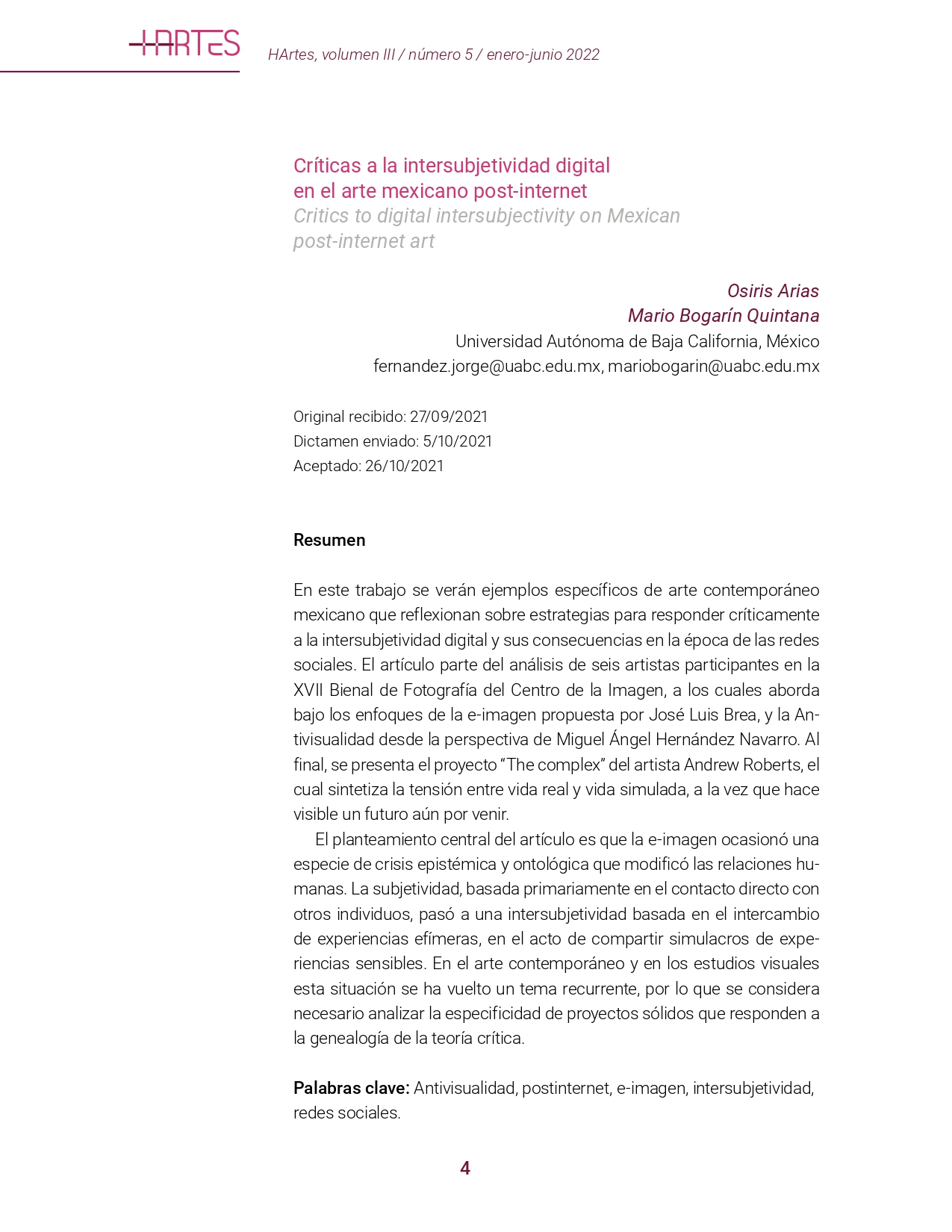Abstract
In this work we will see specific examples of Mexican contemporary art that reflect on strategies to respond critically to digital intersubjectivity and its consequences in the era of social networks. The article starts from the analysis of six artists participating in the XVII Biennial of the Image Center, which are approached from the proposal of the e-image by José Luis Brea, and the Antivisuality from the perspective of Miguel Ángel Hernández Navarro. In the end, the project The complex by artist Andrew Roberts is presented, which synthesizes the tension between real life and simulated life, while making a future visible yet to come.
The central approach of the article is that e-image caused a kind of epistemic and ontological crisis that modified human relationships. Subjectivity, based primarily on direct contact with other individuals, became an intersubjectivity fundamentally based on the exchange of ephemeral experiences, in the act of sharing simulated sensitive experiences. In contemporary art and in visual studies this situation has become a recurring theme, so it is considered necessary to analyze the specificity of solid projects that respond to the genealogy of critical theory.
References
Beriaín, J. (2008). Aceleración y tiranía del presente: la metamorfosis en las estructuras temporales de la modernidad. México: Anthropos.
Barthes, R. (1980). La cámara lúcida: nota sobre la fotografía. Barcelona: Paidós.
Brea, J. (2010). Las tres eras de la imagen. (1st ed., pp.80-81) Madrid: ediciones Akal
_____. (2014). El cristal se venga. Textos, artículos e iluminaciones de José Luis Brea. Virginia Jaua (ed). México: Fundación Jumex Arte Contemporáneo.
Byung-Chul H. (2017). La expulsión de lo distinto. Barcelona: Herder Ed.
Castoriadis, C. (2013). La institución imaginaria de la sociedad. Barcelona: Tusquets Editores.
Centro de la imagen. (28 de mayo de 2016). VII Bienal de Fotografía. Disponible en: https://centrodelaimagen.cultura.gob.mx/bienal-de-fotografia/xvii/index.html
Chrisholm, R. (1960). Realism and the background of phenomenology. Whitefish: Literary Licensing.
Foucault, M. (1970). El orden del discurso. México: Tusquets Editores.
Fontcuberta, J. (2016). La furia de las imágenes. Notas sobre postfotografía. Barcelona: Galaxia Gutenberg.
Guasch, A. (2010). Arte y Archivo. 1920-2010. Genealogías, tipologías discontinuidades. Tres cantos: Ediciones AKAL SA.
Groys, B. (2016). In the flow. Nueva York: Verso.
Hernández-Navarro, M. A. (2007). El Archivo escotómico de la Modernidad [Pequeños pasos para una cartografía de la visión]. Alcobendas: Colección de Arte Público & Fotografía.
Martín Prada, J. (2015). Prácticas artísticas e internet en la época de las redes sociales. (2da ed., pp.24-29). Tres Cantos: Ediciones Akal.
Shore, R. (2013). Post-Photography: The artist with a Camera. Reino Unido: Lawrence King.
Virilio, P. (2006). Estética de la desaparición. Barcelona: Anagrama editores.
Warburg, Aby. (2004) El ritual de la serpiente. México: SextopisoBrea, J. (2010). Las tres eras de la imagen. (1st ed., pp.80-81) Madrid: ediciones Akal.

This work is licensed under a Creative Commons Attribution-NonCommercial 4.0 International License.
Copyright (c) 2022 HARTES

